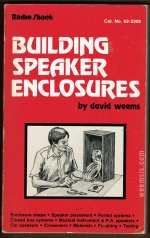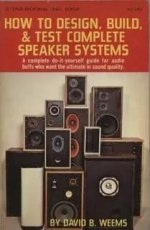I just picked up the 7th edition of the nearly universally suggested book by Vance Dickason, and it seems to me to be written at a “201” level. Is there a similar reference book that would be “101/102” or Intro level? I can see this being helpful after a while…
"An Introduction to Loudspeakers & Enclosure Design" by V Capel is a bit dated, but definitely a level or 2 down from the Cookbook.
A lot of us started with issue one of Speaker Builder. 🙂
I also suggest Testing Loudspeakers by Joe D'Apolitto. It was the original heavy duty before we had all these cheap CAD tools that do the hard work for us. DATS or as I prefer WooferTester II.
Readingf the manuals for WInISD, PSDLite, REW, HOLM, Arta, Boxsim , Vituix, Xdir, Xsim, TrueRTA, Edge, ad nauseum.
There is a lot on the WEB. Many basic tutorials. Some good, some OK, some totally wrong, so "buyer beware"
If just starting, are you competent in basic AC/DC electronics? Again, tons of stuff on-line. Back in the "dark ages" ( when I was starting) I had to pay half my income to go to tech school for what you can get free!
The great thing is is is just well established engineering, but that does mean it is engineering and you are way ahead to understand the physics. No magic. No abstract art. But there are usually more than one ways to your goal and like most engineering many tradeoffs.
I also suggest Testing Loudspeakers by Joe D'Apolitto. It was the original heavy duty before we had all these cheap CAD tools that do the hard work for us. DATS or as I prefer WooferTester II.
Readingf the manuals for WInISD, PSDLite, REW, HOLM, Arta, Boxsim , Vituix, Xdir, Xsim, TrueRTA, Edge, ad nauseum.
There is a lot on the WEB. Many basic tutorials. Some good, some OK, some totally wrong, so "buyer beware"
If just starting, are you competent in basic AC/DC electronics? Again, tons of stuff on-line. Back in the "dark ages" ( when I was starting) I had to pay half my income to go to tech school for what you can get free!
The great thing is is is just well established engineering, but that does mean it is engineering and you are way ahead to understand the physics. No magic. No abstract art. But there are usually more than one ways to your goal and like most engineering many tradeoffs.
Thanks for the input. Although a degreed MET, I only had to take one class in Electrical Engineering. That was over 30 years ago so I know just enough to be dangerous.
The electronics isn’t my hang up. I’m more interested in box type/sizing and mating to drivers, etc. I’ve found a good site to help, but was expecting it to be in the book (calculating qtc for instance). Haven’t found it yet.
Basically, I’m starting backwards: with an existing speaker cabinet and seeing what I can do. Seems everything is starting the other way (from scratch). I’ll get there eventually.
thanks again
The electronics isn’t my hang up. I’m more interested in box type/sizing and mating to drivers, etc. I’ve found a good site to help, but was expecting it to be in the book (calculating qtc for instance). Haven’t found it yet.
Basically, I’m starting backwards: with an existing speaker cabinet and seeing what I can do. Seems everything is starting the other way (from scratch). I’ll get there eventually.
thanks again
I have read a zillion books on loudspeakers. Each has some useful gems. I even wrote a real short one. Never published. STill hve the original manuscript (predates Dickason). I also OCRed the original typed manuscript by Ted Jordan and i believe it can be found at the Jordan website.
AFAIR Weems has some solid construction information, but little in the way of figuring out what box to put it in.
Dickason was the first i recall with real formulas. But i ran into those formulas all the time, the set of AES loudspeaker anthologies is really loaded with information.
Olson’s (Acoustics?), Berenek, Benson provide significant background and form a large amount of the basis that more recent books are based on.
And the most recent significant tome is Toole’s Sound Reproduction.
But once you have a good modeler, sealed & BR becomes fairly straightforward (do note that with the degrees of freedom possible for a reflex, it still takes other knowlege to do one that works well). TLs/horns, and other ¼ or ½ wave designs, require more sophisticated software which is somewhat scarce. There are even more degrees of freedom to allow room for poor designs. There are no books that cover these subjects, it lives mostly on the web, much of it here.
For front horns, theory and history, https://audioxpress.com/article/book-review-exploring-high-quality-horn-loudspeaker-systems, a text book quality book.
A significant budget in terms of $$$ and even more time to consume all those (i started ready AES and speaker builder in 1972(?)) -- which reminds me of all the aXp magazines. And Wireless World, and more. Many of those have been scanned and are on-line. And there is something to be learned with desriptions and pictures of what has been made (those review magazines are not useless).
dave
AFAIR Weems has some solid construction information, but little in the way of figuring out what box to put it in.
Dickason was the first i recall with real formulas. But i ran into those formulas all the time, the set of AES loudspeaker anthologies is really loaded with information.
Olson’s (Acoustics?), Berenek, Benson provide significant background and form a large amount of the basis that more recent books are based on.
And the most recent significant tome is Toole’s Sound Reproduction.
But once you have a good modeler, sealed & BR becomes fairly straightforward (do note that with the degrees of freedom possible for a reflex, it still takes other knowlege to do one that works well). TLs/horns, and other ¼ or ½ wave designs, require more sophisticated software which is somewhat scarce. There are even more degrees of freedom to allow room for poor designs. There are no books that cover these subjects, it lives mostly on the web, much of it here.
For front horns, theory and history, https://audioxpress.com/article/book-review-exploring-high-quality-horn-loudspeaker-systems, a text book quality book.
A significant budget in terms of $$$ and even more time to consume all those (i started ready AES and speaker builder in 1972(?)) -- which reminds me of all the aXp magazines. And Wireless World, and more. Many of those have been scanned and are on-line. And there is something to be learned with desriptions and pictures of what has been made (those review magazines are not useless).
dave
Last edited:
Far beyond any textbook.For front horns, theory and history, https://audioxpress.com/article/book-review-exploring-high-quality-horn-loudspeaker-systems, a text book quality book.
Some invaluable knowledge caught between the covers.
But also a lap-breaker. Too big and heavy to hold in the hand, or even in a recliner.
The best textbooks have the same breadth and width, the horn book is 1200 pages, really really solid, but has some holes (no real look at BLHs)).
dave
dave
Another vote for Weems. But I think I learned more from the various Speakerlab booklets written by Pat Snyder. And quite a bit from just playing with the DOS speaker design program, "Perfect Box". And from the discussions on the DIY speaker list.
from the old days to days which should not end for awhile
http://www.tubebooks.org/file_downloads/Jensen_spkr_plans.pdf
https://frank.pocnet.net/other/Phil...onBook_BuildingHiFiSpeakerSystems_1970-10.pdf
https://nvhrbiblio.nl/biblio/boek/256-An-Introduction-To-Loudspeaker-Enclosure-Design.pdf
http://www.nvhrbiblio.nl/biblio/boek/Briggs - Cabinet handbook.pdf
http://www.introni.it/pdf/Loudspeaker & Loudspeaker Cabinets 1966.pdf
https://worldradiohistory.com/UK/Be...-2nd-Book-Of-Hi-Fi-Loudspeaker-Enclosures.pdf
https://volvotreter.de/downloads/Dinsdale_Horns_1.pdf
https://pure.tue.nl/ws/files/3397667/240847.pdf
https://etd.lib.metu.edu.tr/upload/3/12607890/index.pdf
http://ozvuke.pro/index.php?act=attach&type=post&id=1548
http://www.tubebooks.org/file_downloads/Jensen_spkr_plans.pdf
https://frank.pocnet.net/other/Phil...onBook_BuildingHiFiSpeakerSystems_1970-10.pdf
https://nvhrbiblio.nl/biblio/boek/256-An-Introduction-To-Loudspeaker-Enclosure-Design.pdf
http://www.nvhrbiblio.nl/biblio/boek/Briggs - Cabinet handbook.pdf
http://www.introni.it/pdf/Loudspeaker & Loudspeaker Cabinets 1966.pdf
https://worldradiohistory.com/UK/Be...-2nd-Book-Of-Hi-Fi-Loudspeaker-Enclosures.pdf
https://volvotreter.de/downloads/Dinsdale_Horns_1.pdf
https://pure.tue.nl/ws/files/3397667/240847.pdf
https://etd.lib.metu.edu.tr/upload/3/12607890/index.pdf
http://ozvuke.pro/index.php?act=attach&type=post&id=1548
David Weems also wrote books on how to raise goats.
https://www.goodreads.com/book/show/682238.Raising_Goats
https://www.goodreads.com/book/show/682238.Raising_Goats
Thanx freddi, i hadn’t seen some of those.from the old days to days
This is the full Dinsdale trilogy: http://p10hifi.net/planet10/TLS/downloads/Dinsdale-Horns-3parts.pdf
Note that this, i consider, to be essential horn basics. Just enuff to get you in touble.
dave
That book literally started me on the road to becoming a loudspeaker engineer-THANK YOU David. A big caveat is that book treats crossovers as textbook formulas into resistors, which is not how real speakers are at all. I'm not sure who has a better explanation of how crossovers work.I find David Weems to be an excellent tutor!
Yes there is a lot there. I won't disagree it's a "201" kind of thing, but observe that any speaker stuff (from my original Weems book to my copy of Richards Small's thesis) needs several readings to start to percolate into understanding.Vance Dickason, and it seems to me to be written at a “201” level.
Only the one book. It is popular around here.David Weems also wrote books on how to raise goats.
Before Weems, less abstract than Olson, was Briggs.
I have a copy of the above Briggs' Loudspeakers book and never tire of referring to it! Highly recommended!
My 1967 Wharfedale RS/12/DD full range drivers have been housed, at various times, in the bass reflex and distributed port enclosure designs described in the book.
Loudspeakers is a great basic primer, but predates the days of T/S parameters. Briggs was a pioneer who, through listening tests and basic measurement, produced cabinet designs that complimented the particular characteristics of the Wharfedale drivers of the day.
My 1967 Wharfedale RS/12/DD full range drivers have been housed, at various times, in the bass reflex and distributed port enclosure designs described in the book.
Loudspeakers is a great basic primer, but predates the days of T/S parameters. Briggs was a pioneer who, through listening tests and basic measurement, produced cabinet designs that complimented the particular characteristics of the Wharfedale drivers of the day.
- Home
- Design & Build
- Construction Tips
- Precursor to Loudspeaker Design Cookbook?

